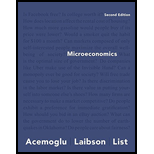
Microeconomics (2nd Edition) (Pearson Series in Economics)
2nd Edition
ISBN: 9780134492049
Author: Daron Acemoglu, David Laibson, John List
Publisher: PEARSON
expand_more
expand_more
format_list_bulleted
Question
Chapter 11, Problem 2P
(a)
To determine
The marginal product of Arabica Alley, Barista Bar, and Coffee Café.
(b)
To determine
The allocation of workers with the intent to maximize total coffee production in a planned economy.
(c)
To determine
The total coffee production and equilibrium wage in a decentralized economy.
Expert Solution & Answer
Want to see the full answer?
Check out a sample textbook solution
Students have asked these similar questions
The following are correct descriptions about the concept of Marginal Productivity of Labor (MPL), EXCEPT:
Question 1 options:
MPL measures the extra production generated by adding one extra unit of labor.
MPL initially increases and eventually declines as more units of Labor are added.
From the producer's perspective, The optimal level of labor is the one when MPL = Market Wage and MPL is still Increasing.
If MPL increases for any given amount of labor, it will lead to a shift up of the Demand for Labor.
A custom motorcycle company can produce more motorcycles if it has more workers. The company has experimented with hiring workers in teams of four and has come up with the following table relating the number of workers to the companies annual production
Part1.
Using the straight line tool, graph the production function based on the information given. Construct the curve using four line segments joined end to end. Don it graph the individual points.
Part 2.
Give the numeric answers to tap decimals.
A. The marginal product of each of the first four workers is ______
B. The marginal product of each of the second four workers is _______
C. Diminishing returns begin with the _______ worker.
Can you please check my answers for the following question?
Mandy owns a small coffee shop. Her production function is q=2K0.5L where q is the number of cups of coffee produces, K is the number of coffee machines, and L is the number of employees.
If K=10 and L=20, the marginal rate of technical substitution is: 1
MLP= 2K0.5
MLK = L/K0.5
MRTS= 2K/L = 2(10)/20 =1
MRTS = w/r
Starting from 10 machines and 20 employees, if Joe hires one more employee, then he can use ______ fewer machine(s) and still produce the same quantity of coffee.
1 fewer machine
Chapter 11 Solutions
Microeconomics (2nd Edition) (Pearson Series in Economics)
Knowledge Booster
Similar questions
- Suppose firms A and B each make T-shirts. Firm A's production function is q = L0.5 K0.5. Firm B's production function is q = 1.2* L0.5 K0.5. If the two firms each hire the same amounts of capital and labor, compare the two firms in terms of APL and MPL.arrow_forwardSuppose that low-productivity workers all have marginal products of 8 and high-productivity workers all have marginal products of 16. The community has equal numbers of each type of worker. A firm cannot directly tell the difference between the two types of workers. Without any further information, the firm is willing to offer a wage at the average productivity. The local community college offers a course in microeconomics, which does not increase productivity for either type of workers. High-productivity workers think taking this course is as bad as a wage cut of $3, and low-productivity workers think it is as bad as a wage cut of $9. With the certificate, the firm is willing to offer a high wage of $16. Without it, the firm is willing to offer a low wage of $8. But the firm cannot still tell the true productivity. In this case, is it worth for the low-productivity workers taking the course? (Yes, No, or Uncertain) Thus, this situation will lead to a (pooling, or separating)…arrow_forwardThe production engineers at Impact Industries have derived the optimal combinations of labor and capital. These are the only two inputs used by Impact. The following chart shows the combinations of labor and capital for three levels of output. Q is the output level. L* is the optimal amount of labor. K* is the optimal amount of capital. The price of labor is $90 per unit. The price of capital is $15 per unit. Q L* K* 120 5 20 180 7 7 240 12 24arrow_forward
Recommended textbooks for you
 Microeconomics: Private and Public Choice (MindTa...EconomicsISBN:9781305506893Author:James D. Gwartney, Richard L. Stroup, Russell S. Sobel, David A. MacphersonPublisher:Cengage Learning
Microeconomics: Private and Public Choice (MindTa...EconomicsISBN:9781305506893Author:James D. Gwartney, Richard L. Stroup, Russell S. Sobel, David A. MacphersonPublisher:Cengage Learning Economics: Private and Public Choice (MindTap Cou...EconomicsISBN:9781305506725Author:James D. Gwartney, Richard L. Stroup, Russell S. Sobel, David A. MacphersonPublisher:Cengage Learning
Economics: Private and Public Choice (MindTap Cou...EconomicsISBN:9781305506725Author:James D. Gwartney, Richard L. Stroup, Russell S. Sobel, David A. MacphersonPublisher:Cengage Learning Principles of Economics (MindTap Course List)EconomicsISBN:9781305585126Author:N. Gregory MankiwPublisher:Cengage Learning
Principles of Economics (MindTap Course List)EconomicsISBN:9781305585126Author:N. Gregory MankiwPublisher:Cengage Learning Principles of Economics, 7th Edition (MindTap Cou...EconomicsISBN:9781285165875Author:N. Gregory MankiwPublisher:Cengage Learning
Principles of Economics, 7th Edition (MindTap Cou...EconomicsISBN:9781285165875Author:N. Gregory MankiwPublisher:Cengage Learning Exploring EconomicsEconomicsISBN:9781544336329Author:Robert L. SextonPublisher:SAGE Publications, Inc
Exploring EconomicsEconomicsISBN:9781544336329Author:Robert L. SextonPublisher:SAGE Publications, Inc

Microeconomics: Private and Public Choice (MindTa...
Economics
ISBN:9781305506893
Author:James D. Gwartney, Richard L. Stroup, Russell S. Sobel, David A. Macpherson
Publisher:Cengage Learning

Economics: Private and Public Choice (MindTap Cou...
Economics
ISBN:9781305506725
Author:James D. Gwartney, Richard L. Stroup, Russell S. Sobel, David A. Macpherson
Publisher:Cengage Learning


Principles of Economics (MindTap Course List)
Economics
ISBN:9781305585126
Author:N. Gregory Mankiw
Publisher:Cengage Learning

Principles of Economics, 7th Edition (MindTap Cou...
Economics
ISBN:9781285165875
Author:N. Gregory Mankiw
Publisher:Cengage Learning

Exploring Economics
Economics
ISBN:9781544336329
Author:Robert L. Sexton
Publisher:SAGE Publications, Inc